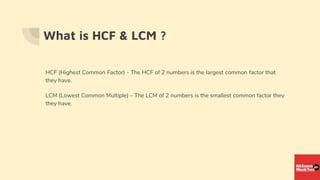Quick Guide For HCF & LCM
•Descargar como PPTX, PDF•
1 recomendación•439 vistas
What is HCF? What is LCM? How you calculate HCF & LCM of numbers & fractions quickly? Find out in this short presentation by https://allexammocktest.in
Denunciar
Compartir
Denunciar
Compartir

Recomendados
Más contenido relacionado
La actualidad más candente
La actualidad más candente (20)
Similar a Quick Guide For HCF & LCM
Similar a Quick Guide For HCF & LCM (20)
3 lcm and lcd, addition and subtraction of fractions

3 lcm and lcd, addition and subtraction of fractions
Solving linear programming model by simplex method

Solving linear programming model by simplex method
Último
This presentation was provided by William Mattingly of the Smithsonian Institution, during the third segment of the NISO training series "AI & Prompt Design." Session Three: Beginning Conversations, was held on April 18, 2024.Mattingly "AI & Prompt Design: The Basics of Prompt Design"

Mattingly "AI & Prompt Design: The Basics of Prompt Design"National Information Standards Organization (NISO)
APM Welcome
Tuesday 30 April 2024
APM North West Network Conference, Synergies Across Sectors
Presented by:
Professor Adam Boddison OBE, Chief Executive Officer, APM
Conference overview:
https://www.apm.org.uk/community/apm-north-west-branch-conference/
Content description:
APM welcome from CEO
The main conference objective was to promote the Project Management profession with interaction between project practitioners, APM Corporate members, current project management students, academia and all who have an interest in projects.APM Welcome, APM North West Network Conference, Synergies Across Sectors

APM Welcome, APM North West Network Conference, Synergies Across SectorsAssociation for Project Management
Último (20)
Mattingly "AI & Prompt Design: The Basics of Prompt Design"

Mattingly "AI & Prompt Design: The Basics of Prompt Design"
Mixin Classes in Odoo 17 How to Extend Models Using Mixin Classes

Mixin Classes in Odoo 17 How to Extend Models Using Mixin Classes
Z Score,T Score, Percential Rank and Box Plot Graph

Z Score,T Score, Percential Rank and Box Plot Graph
APM Welcome, APM North West Network Conference, Synergies Across Sectors

APM Welcome, APM North West Network Conference, Synergies Across Sectors
ICT Role in 21st Century Education & its Challenges.pptx

ICT Role in 21st Century Education & its Challenges.pptx
SECOND SEMESTER TOPIC COVERAGE SY 2023-2024 Trends, Networks, and Critical Th...

SECOND SEMESTER TOPIC COVERAGE SY 2023-2024 Trends, Networks, and Critical Th...
Quick Guide For HCF & LCM
- 1. What is HCF & LCM ? HCF (Highest Common Factor) - The HCF of 2 numbers is the largest common factor that they have. LCM (Lowest Common Multiple) – The LCM of 2 numbers is the smallest common factor they they have.
- 2. Example - 12,20 and 30 See there are only two common factors 1 and 2. 2 is the largest common factor. Similarly, 60 is the smallest common multiple. So, The answer is - 2 is the HCF and 60 is the LCM.
- 3. Tricks to Find Out HCF & LCM Quickly We shall find out the HCF and LCM of 18, 27 and 30 in 3 quick steps. Step-1 1. Start by factorizing all three numbers in terms of prime factors So now there are 3 prime factors - 2, 3 and 5.
- 4. Step-2 Now we are going to express the above 3 equations in such a way that all 3 of them contains 2, 3 and 5. Look closely –
- 5. Step 3 In this last step we shall find both the HCF and LCM – ● For HCF, we take the smallest power of 2, 3 and 5 that is common in the 3 equations and multiply them. ● For LCM, we take the largest power of 2, 3 and 5 in the 3 equations and multiply them. [Please note that this power does not have to be common]
- 6. Practice Problems Find the HCF and LCM of the following numbers using the method above. (Try to solve them as fast as you can.) – 1) 12, 28 and 44 2) 132, 246 and 444 3) 121, 605 and 12321
- 7. HCF and LCM of Fractions ● The formula for finding the HCF of fractions is – ● The formula for finding the LCM of fractions is –
- 8. The Easy Way To Remember The Formula The numerators do what you have to do. The denominators do opposite of what you have to do. If you need to do HCF, then with the numerators of the fractions find the HCF. Then, find the LCM with the denominators. Finally form the fraction. To find the LCM, find the LCM of the numerators. Next, find the HCF of the denominators. Then form the fraction.
- 9. Solve Example With This Formula –
- 10. Solve Other Example -
- 11. Practise Set - Find the HCF & LCM of the following Example
- 12. Another Important Formula If M and N are two numbers. And X and Y are the HCF and LCM of M and N, then – M x N = X x Y That means, The product of two numbers = HCF x LCM
- 13. Example Find the smallest such number, which is greater than 3 and when divided by 4, 5, 6 always leaves the same remainder 3. Solution – This problem can be solved in 2 steps – 1. Find the smallest number that is divisible by 4, 5, 6. Obviously, the smallest such number is their LCM = LCM (4, 5, 6) = 60. 2. Add 3 to that number to get the required answer. Therefore the answer is = 60 + 3 = 63.
- 14. Want To Solve More Questions ? Visit our website - www.allexammocktest.in/exams